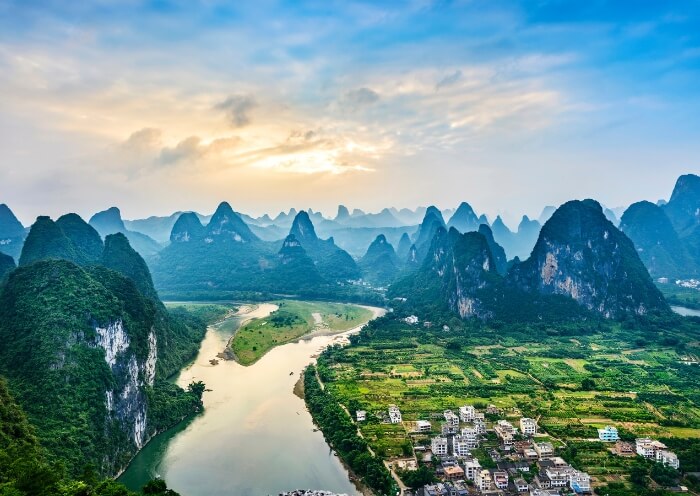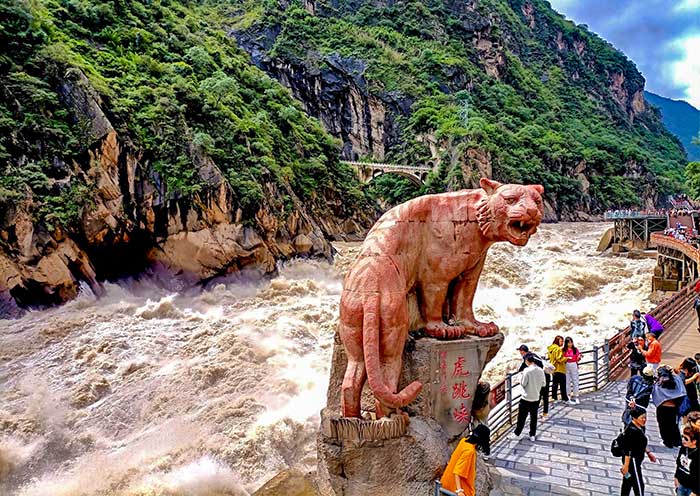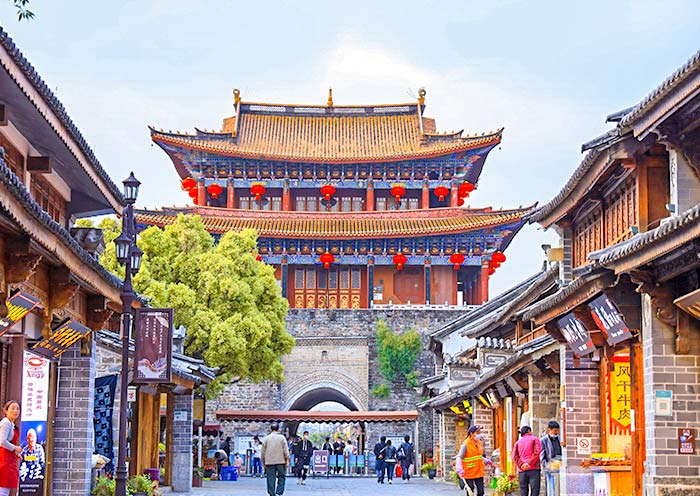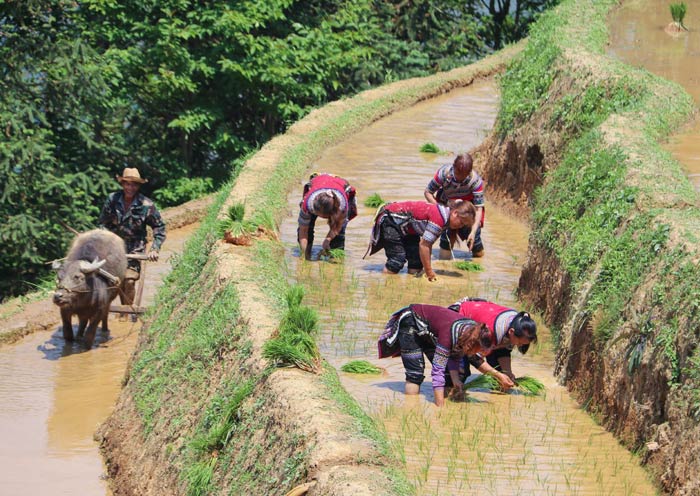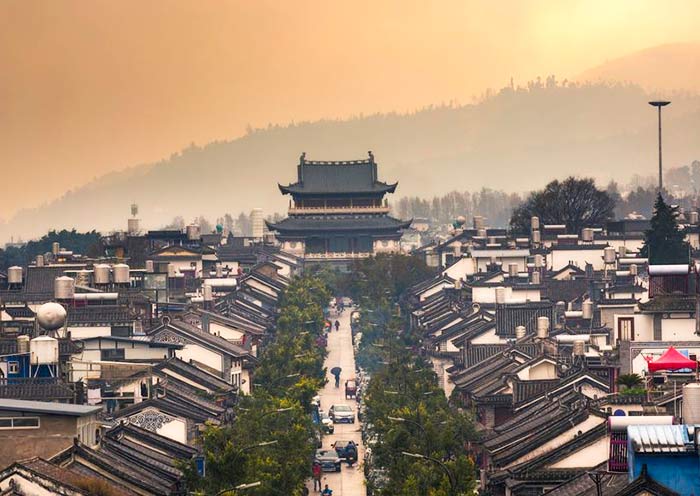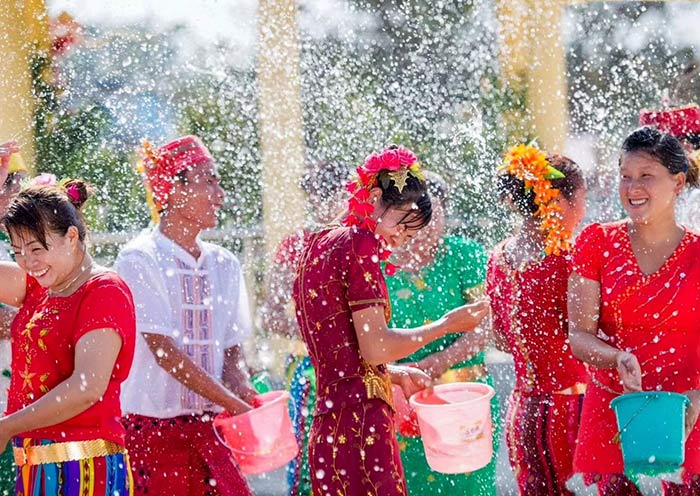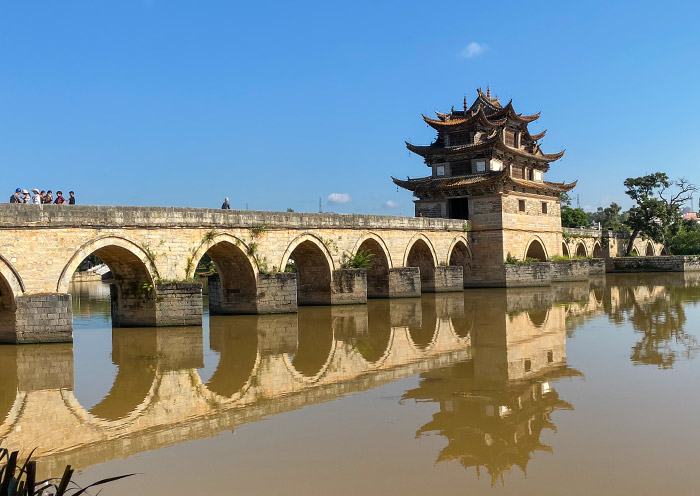We had an amazing trip and on behalf of all my trip mates, I would like to thank Hannah from Asia Odyssey sincerely for going through a lengthy liaison with me before the trip to plan a comprehensive itinerary. This was also carried out very smoothly when we were in Yunnan, thanks to our two guides Frank & Nancy - they’re amazing guides who are professional and very knowledgeable, helping us take plenty of great pictures and videos too. Frank was always patient with us, trying his best to attend to all our needs. Nancy was always thinking several steps ahead of us, recommending us special places with superb food for us to try and arranging for the food to be prepared and cooked so it would all be ready just as we reached so as to save time. Our driver 何师傅 was fabulous as well, always helping us with our luggage and offering friendly snippets of advice. We really appreciated how he drove our luggage all the way from Kunming to Dali and then from Lijiang all the way back to Kunming - this saved us A LOT of trouble and time lugging our huge suitcases on and off the train. A huge thank you to whoever from the company who contributed to this arrangement too
9 Days Guilin Yunnan Tour with Kunming Dali Lijiang Tiger Leaping Gorge - Best of Southwestern China
- Highlights
- Itinerary
- Price
- Trip Notes
- Accommodation
- Photos
- Reviews
Surreal Landscapes of Guilin and Vibrant Diversity of Yunnan
Looking for a unique adventure in the southwestern part of China? Join us on our 9 Day Guilin Yunnan Tour, a journey through some of the most picturesque and culturally rich regions of Southern China, where the surreal landscapes of Guilin and the vibrant diversity of Yunnan truly come alive.
Begin your adventure in Guilin, where you'll cruise cruise through a living traditional Chinese painting, with limestone karsts towering over serene waters. Just north of Guilin, you can fully enjoy the world-famous Longji Rice Terraces which is home to Zhuang and Yao ethnic groups.
Next, travel to Yunnan, a province celebrated for its ethnic diversity and dramatic landscapes. Explore its major cities including Kunming, Dali, Lijiang, and Tiger Leaping Gorge. Starting in Kunming, where you will be captivated by the Stone Forest, a set of limestone formations that resemble a forest made of stone. Then, travel to Dali and Lijiang where you'll encounter a mosaic of ethnic cultures, each with its traditions and customs. Visit the ancient towns of Dali and Lijiang, and get lost in their cobblestone streets and charming architecture. You won't miss the natural beauty either. Ride a bike alongside the picturesque Erhai Lake witness the impressive Jade Dragon Snow Mountain and hike through the breathtaking Tiger Leaping Gorge.
Don't miss out on this opportunity to explore the natural wonders and diverse ethnic heritage of Guilin and Yunnan.
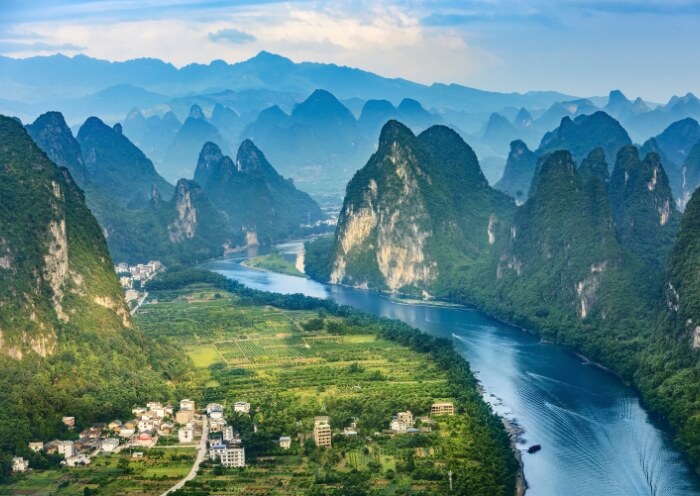
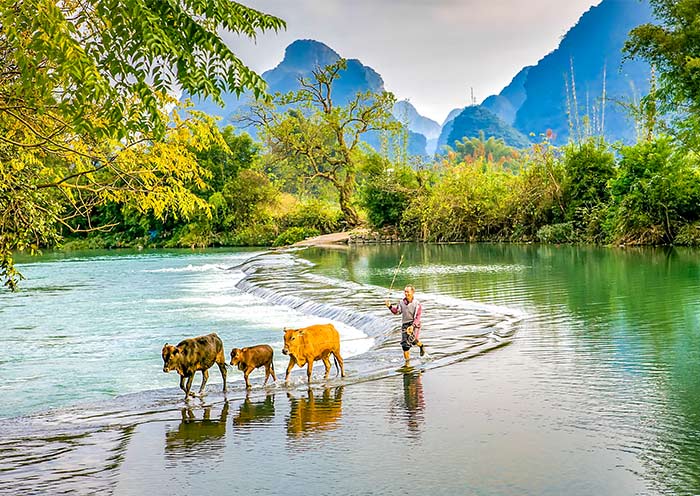
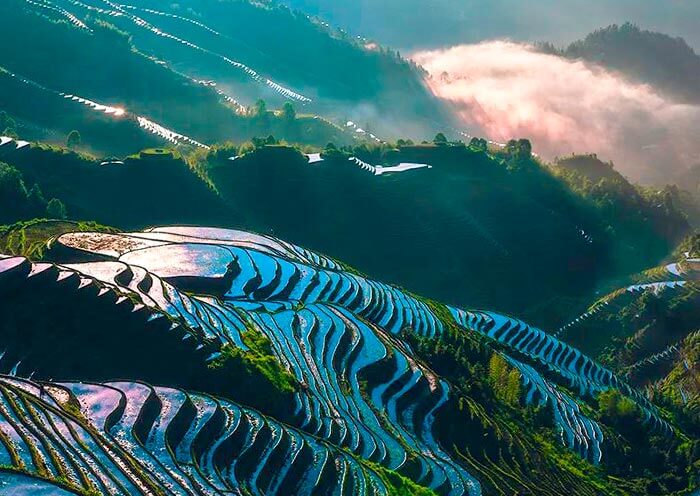
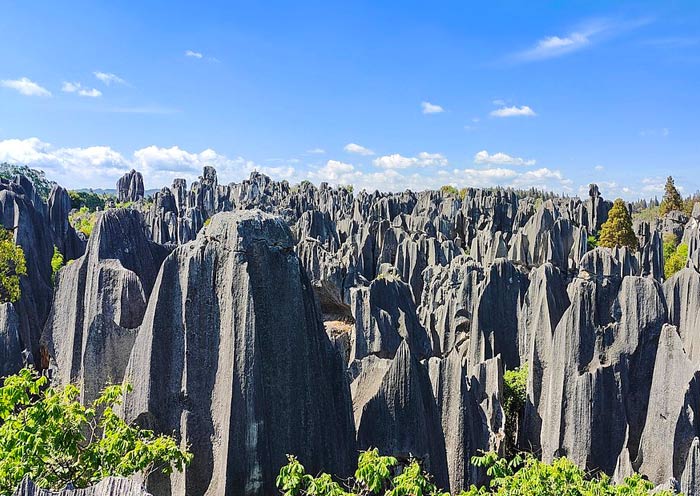
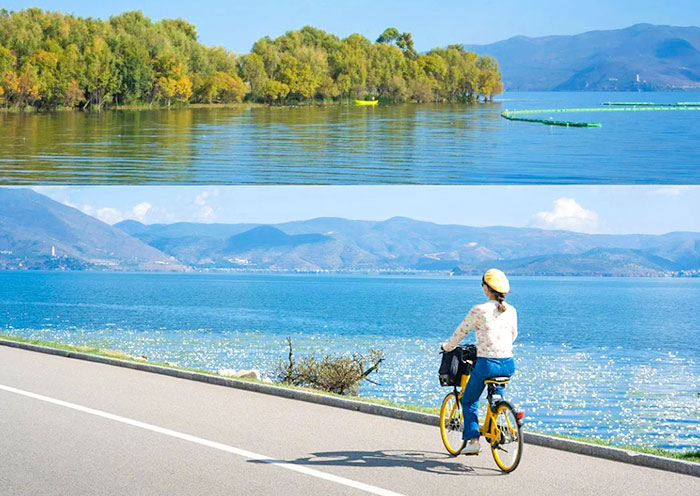
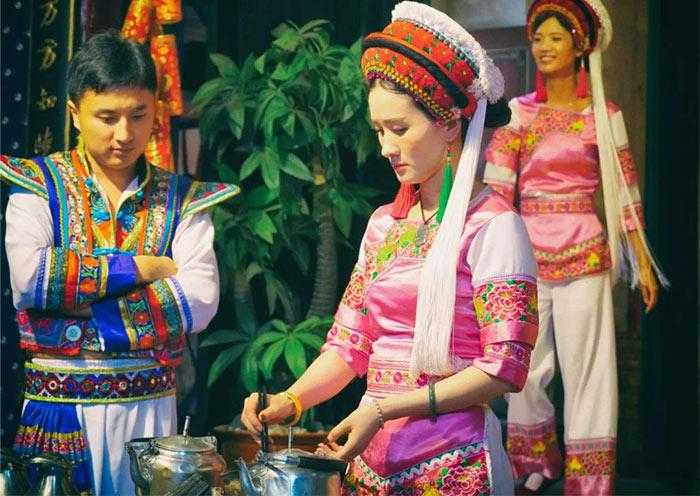
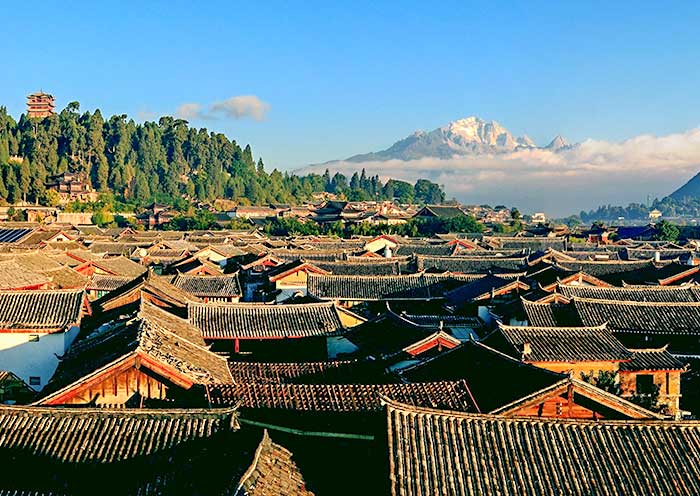
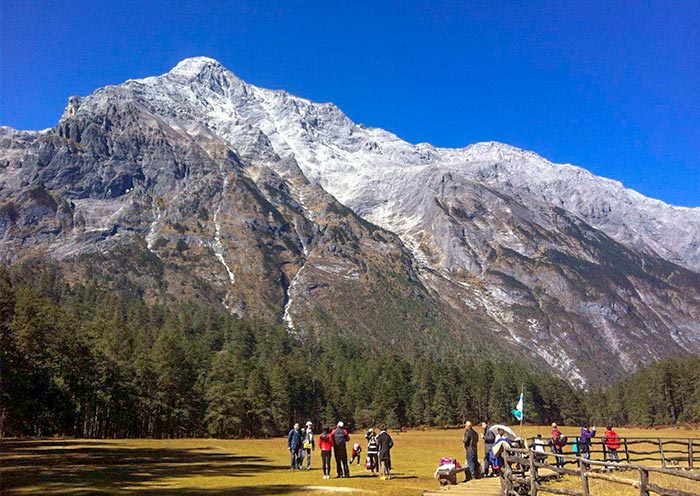


Itinerary at a Glance
Guangxi Guilin (1 Day)
Airport Pick-up
Guangxi Longsheng Longji Rice Terrace(1 Day)
Huangluo Yao Village, Ping'an Village, Longji Rice Terrace, Dazhai Village
Guangxi Yangshuo County (1 Day)
Yangshuo Countryside, West Street, Bamboo Raft along the Yulong River
Guangxi Guilin (1 Day)
Elephant Trunk Hill, Reed Flute Cave, Li River Cruise, Airport/ Train Drop-off
Yunnan Kunming (1 Day)
Airport/ Train Pick-up, Stone Forest, Yuantong Temple, Green Lake Park
Yunnan Dali (2 Days)
Three Pagodas of Chongsheng Temple, Erhai Lake Bike Ride, Morning Market, Xizhou Ancient Town, Zhoucheng Village & Tie-dye, Free Time in Dali Ancient Town
Yunnan Lijiang (2 Days)
Lijiang Old Town & Mu Palace, Black Dragon Pond Park, Jade Dragon Snow Mountain & Blue Moon Valley, Baisha Village & Baisha Murals, Shuhe Ancient Town, the First Bend of the Yangtze River, Tiger Leaping Gorge
Itinerary Day by Day
Ni Hao! Welcome to Guilin, the most picturesque paradise in China! Upon your arrival at Guilin airport/train station, the tour guide and driver will meet you at the exit, greet you, and escort you directly to the downtown area, where they will help you check in at your hotel.
Arrival Options: Travelers can reach Guilin by taking a flight or a train. Guilin Lijiang Airport has flights connecting to major cities such as Beijing, Xi’an, Shanghai, Chengdu, Chongqing, and Hangzhou, among others. Guilin has three main train stations in the downtown area: Guilin Railway Station, Guilin North, and Guilin West. Travelers can take high-speed trains to Guilin from Hong Kong (4 hours), Guangzhou (3 hours), Chongqing (4.5-5 hours), Chengdu (5.5-6 hours), Changsha (2.5-3 hours), Zhangjiajie (7 hours), and other cities.
Free Time Suggestions:
If you happen to arrive early, you can explore on your own to some of the easily accessible nearby sites. We highly recommend visiting:
1. Jingjiang Prince’s City: It boasts a rich history dating back to the late 14th century, making it older than Beijing's Forbidden City. Once the official residence of Zhu Shouqian, a great-nephew of the first Ming Dynasty emperor, it served as a haven for scholars who achieved the highest rank in the imperial examinations. Immerse yourself in the fascinating stories of its past by exploring the historical buildings, or ascend to the top of Solitary Beauty Peak for a breathtaking panoramic view of Guilin.
2. East West Alley: Step back in time and explore the charming East West Alley, which merges with three ancient streets, offering a glimpse into the rich history of Guilin. Established during the Tang Dynasty, the alley has borne witness to nearly 1400 years of the city's rise and fall. Take a leisurely stroll along the streets and indulge in some local delicacies, such as the famous Guilin Rice Noodles. Immerse yourself in the traditional culture by trying your hand at fan-making, Lijiang River sand and stone painting or even donning a Hanfu, an ancient Chinese costume.
3. Two Rivers and Four Lakes Cruise: When night falls, take a relaxing cruise to sail through the Two Rivers and Four Lakes scenic area. It takes about 1-1.5 hours depending on the route you choose. Sit back, relax and take in the stunning views of the tranquil waters and illuminated landmarks, including ancient bridges, pagodas, and lush gardens.
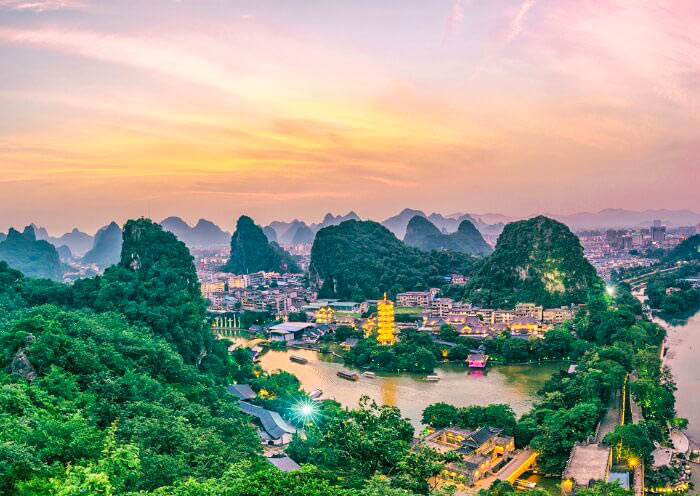
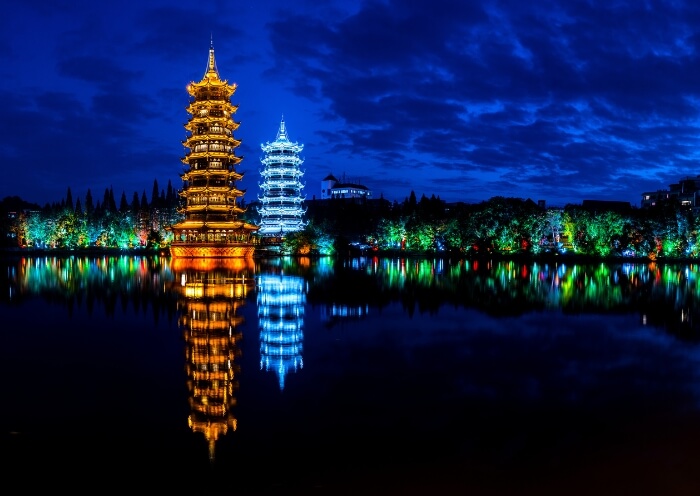
This morning, drive about 77km (2 hours) from Guilin (altitude of 100m) to the Longji Terraces Scenic Area (altitude of 300-1,100m). Inside the scenic area, the winding mountain roads will lead you to the incredible Longji Rice Terraces (Longsheng Rice Terraces) that were created by the ancient Zhuang and Yao minority peoples 2,300 years ago. You will make a stop at Huangluo Yao Village (Long Hair Village) to learn more about the culture of the Yao minority through a performance by local Yao women. After a unique lunch featuring bamboo rice, you will begin hiking in the brilliant Longji Rice Terraces around Ping’an Village.
In the morning, you will arrive at the Huangluo Yao Village (population of over 400) which is famous as “the World's Longest Hair Village”. You will marvel at the dramatically long and pitch-black hairs worn by its women of the Yao ethnic group. The village has over 70 Yao women with hairs over 1 meter (the longest hair of 2.72 meters) which has been listed by Guinness World Record as the “longest hair group”. By watching the performances of villagers (45min, optional), such as folk songs, drum dances, Red Yao wedding customs, sunning red clothes, and combing long hair, you will learn about the history, traditions and way of life of the Red Yao people, such as customs like spinning and weaving. You can even ask Red Yao women to share their secrets on how to take care of their long hair and how to make their Rice Water Shampoo.
Next, head to Ping'an Village for lunch. You'll visit a local villager's restaurant where you can try some local Rice Wine and learn to cook some popular local dishes, such as Bamboo Rice (rice cooked in bamboo tubes) Bamboo Tube Chicken (bamboo stuffed chicken), and Chinese Smoked Pork (smoked Chinese bacon).
In the afternoon, enjoy hiking in the Longji Rice Terraces (Longsheng Rice Terrace) around Ping'an Village. The Longji Rice Terraces are one of the top ten most beautiful terraced fields in the world and the closest terraced fields to a major city. With a history of at least 2,300 years, Longji Rice Terraces are hailed as the "Birthplace of Terraced Fields Worldwide" and a "Globally Significant Agricultural Cultural Heritage". It has not only been included in the list of National Wetland Parks but also represents an important heritage of ancient Chinese water management wisdom and agricultural civilization that has been passed down to this day by ancient Zhuang and Yao peoples. As you walk across the cobbled paths of the Ping'an Rice Terrace Fields, you can reach its famous viewing platforms, such as the Seven Stars Accompany the Moon (880m, Sunrise Viewing Spot) and Nine Dragons and Five Tigers (980m, Sunset Viewing spot). At the Nine Dragons and Five Tigers viewing platform (九龙五虎), you will see why it is named Longji Rice Terrace (Dragon Backbone Rice Terraces).
You can also walk into Ping'an Village along the stone-paved road, where you will find 170 households and over 700 people, all belonging to the Zhuang ethnic group with the surname "Liao". Men wear short gowns made of hand-loomed cloth, while women wear white shirts, black pants, and brightly colored cloth on their heads. Here, you can have a close-up view of the Zhuang people's distinctive stilted houses called "Diaojiaolou" (吊脚楼) in the mountain valley. You may encounter local Zhuang villagers, taste or make unique Zhuang People's food like oil-tea, have the opportunity to learn more about Zhuang ethnic customs and culture, as if you are transported to ancient times.
Take your time to find the best viewpoints to capture the beauty of the incredible terrace fields that exist since ancient times. After the hiking, go back to Guilin.

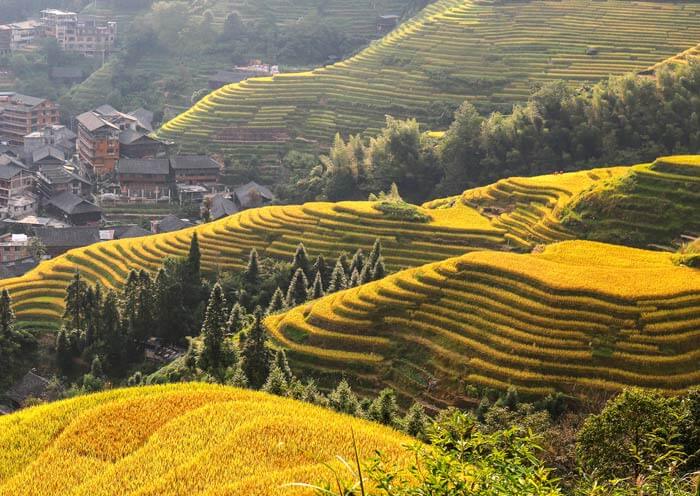
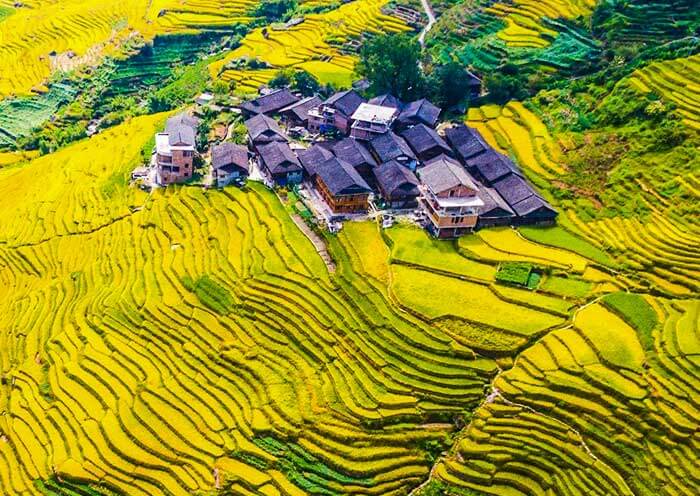

"East or west, Guilin landscape is the best". After breakfast, you will go to explore the most stunning natural scenery along the Li River, which is renowned as one of the “the world’s top 10 watery wonders” by National Geographic. After a 1-hour drive from your hotel to the Mopanshan Pier, embark on a 4-hour relaxing sightseeing Li River cruise to Yangshuo. Throughout the 83-kilometer scenic cruise, you'll be entranced by countless Chinese paintings come to life, with winding rivers and towering Karst peaks in every direction. Marvel at the famous sights along the banks, such as the Immortal Pushing the Mill, Nine-Horse Fresco, Yellow Cloth Shoal reflection, and the picture on the back of the 20 RMB note. You'll also encounter idyllic villages like Xingping Town nestled along the river. (Kindly Note: 1. Lunch is served on the cruise, featuring simple local Chinese cuisine. 2. If you prefer a 4-star Li River cruise, please tell your travel consultant.)
After arriving in Yangshuo, the driver will pick you up from the dock and drive to your hotel in Yangshuo town for a short rest. Once you're ready, step out and let the captivating scenery of Yangshuo's countryside wash over you. Vibrant, green fields stretch out like a sea of emeralds, nestled under a clear, blue sky. The misty karst mountains rise in the distance, their vast and rolling shapes protecting the serene landscape below. The Yulong River, a small offshoot of the Li River, meanders through the scene, its tranquil waters reflecting the stunning surroundings like a living mirror.
Then, it's time to get up close to this rural paradise. You can either hop on a bike or rent a sidecar (optional) to explore the postcard-like karst hills and rice paddies and pass by some tranquil villages. Let all the picturesque scenes please your eyes and your souls to the maximum for total relaxation. At various points, you might also spot locals engaging in their daily chores, farmers tending to their fields, or even children playing along the riverbanks. Dotting the riverbanks are quaint stone houses, their grey slate roofs offering a delightful contrast against the verdant surroundings. There's a solitary water buffalo languidly grazing in the fields, a sight that adds an endearing touch of rural life to the panoramic display.
Next, board a hand-cranked bamboo raft for a journey down the Yulong River. As you ease into the gentle rhythm of the water, you become one with the serene surroundings. The clear water sparkles as it captures the sun's rays, vibrant green river grass dances with the water's flow underneath the surface, lush bamboos and verdant rice paddies dot the riverbanks, the karst mountains are shrouded in soft mist, creating a picturesque scenery that feels like gliding through a beautiful landscape painting. As you float downstream, you'll drift past the ancient bridges, and glide through a variety of dams that interrupt the river flow, creating gentle rapids that splash cool water around, enhancing the joy of the journey.
Then, you will stroll along West Street, which is the most prosperous area in Yangshuo. Restaurants, bars, and souvenir shops along the street are always full of guests. It is a fusion of Western culture and Chinese culture and it is the best place to spend your nightlife here. Whether you want to enjoy a cup of coffee, taste some local food or just throw yourself into the vivid atmosphere... all you can get.
Optional Evening Activity: If you are interested, you can enjoy the amazing evening performance called Impression Liu Sanjie directed by the famous director Zhang Yimou. The show uses the natural landscape as its stage, with the karst mountains and river serving as a unique backdrop. It combines traditional folk music, vibrant costumes, and modern theatrical techniques for a fantastic spectacle of light, sound, and color.



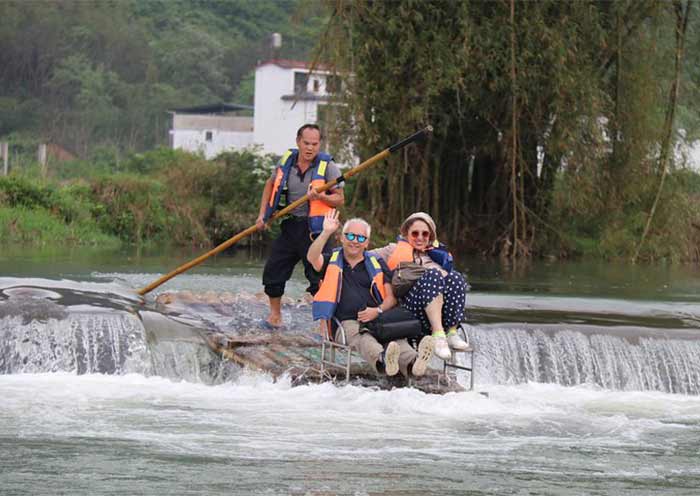
Wake up from the tranquility of Yangshuo to start your journey towards Guilin. As you enjoy a refreshing breakfast, you can take in the natural beauty of the verdant Yangshuo countryside one last time with a leisurely stroll.
After driving back to Guilin, take the time to visit the stunning Elephant Trunk Hill, which is widely regarded as the symbol of Guilin. This natural wonder sits at the confluence of the Li River and Peach Blossom River, resembling a giant elephant drinking water from the river. The hill is made of water-soluble limestone rocks that have been gradually eroded by acidic rainwater over millions of years, creating a unique and breathtaking landscape. Its beauty is so awe-inspiring that it has contributed to the popular saying “桂林山水甲天下”, which means that Guilin's scenery is the best under heaven. Next, take a walk to Water-Moon Cave, a semicircular opening in the rock that represents the space between the elephant's trunk and legs. This cave stands 12 meters high and features several classical Song and Tang dynasty poems inscribed on its walls in Chinese characters.
Afterwards, you will pay a visit to the Reed Flute Cave, also known as the Palace of Nature's Art. Inside the cave, you'll find a stunning array of uniquely shaped and exquisitely transparent stalactites, stalagmites, columns, curtains, and flowers that are truly a sight to behold. These formations create a variety of stunning landscapes, including Lion Peak at Dawn, the Primitive Forest, the Pinnacle of Dragon and Elephant, and the Mountain of Fruits and Flowers, leaving visitors in awe. When illuminated with colorful neon lights, it feels like walking through a magical underground palace that will leave you spellbound. Don’t miss the Crystal Palace, where the water surface reflects off the rock walls, creating a dreamlike scene of dazzling display of light and color. Experience the Water Curtain Movie here, which allows you to observe geological changes such as the growth of stalactites and stalagmites, adding an extra layer of magic to this incredible natural wonder.
After the tour, it will be time to say goodbye to this beautiful city. You will be transferred to the airport or train station for your flight/train to Kunming.
Note: The direct flight from Guilin to Kunming is available every other day. If there is no flight on the day, we will arrange for you to take a high-speed train to Kunming.
Welcome to Kunming, the Capital City of Yunnan Province! Upon arrival in Kunming, your guide will meet you at the airport/train station and escort you to your hotel. You can explore on your own based on your arrival time. Feel free to seek practical suggestions from your tour guide.
Kunming is known as the "Spring City春城" due to its mild year-round climate, making it a popular destination for people from other cities to escape harsh winters or scorching summers. The pleasant climate also results in flowers blooming throughout the year, earning Kunming the nickname "Flower City花都". Kunming is the hometown of Zheng He (郑和1371-1433), the famous Ming Dynasty navigator who led seven voyages from 1405 to 1433, visiting numerous countries in Asia and Africa. Whether you're looking for a relaxing escape, cultural immersion, or a chance to explore breathtaking natural wonders and indulge in delicious Yunnan cuisine, Kunming has something to offer everyone.


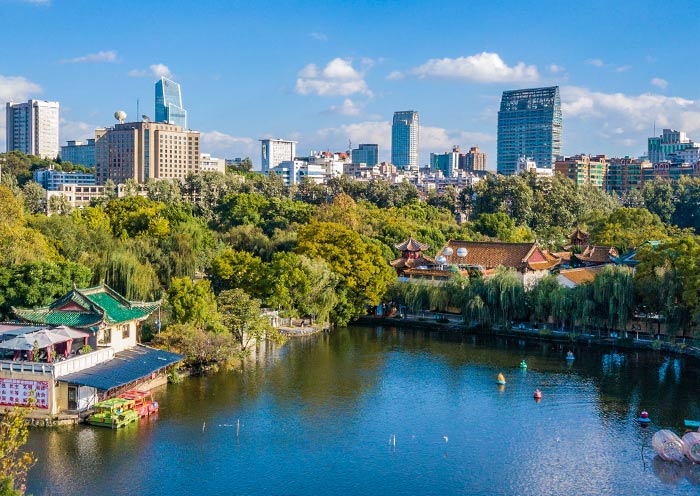
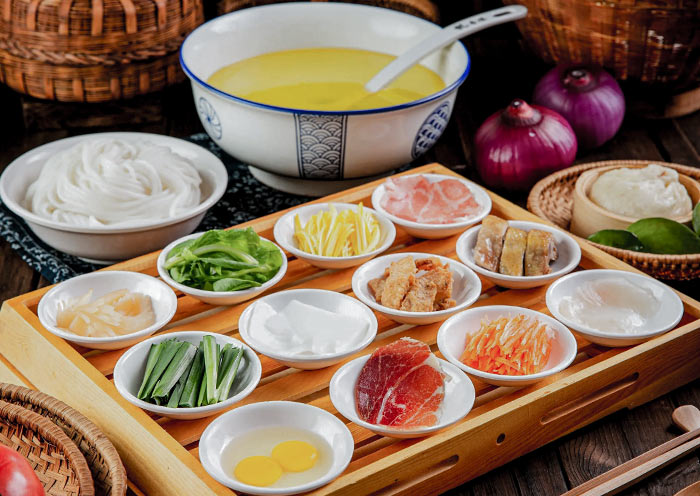
This morning, drive 80km (1.5 hours) to the Stone Forest (a World Heritage Site of South China Karst) for a Kunming Excursion. Afterwards, return to downtown for a Classic Kunming City Tour, including visits to Yuantong Temple (a Zen Buddhist temple), Green Lake Park (Cuihu Park), and more, based on your available time and interests.
In the morning, visit the Stone Forest (a World Heritage Site of South China Karst), a must-see natural wonder that was once submerged under an ancient sea. The Kunming Stone Forest (Shilin) is a national geological park famous for its unique stone forest scenery, which represents the magnificent transformations of the natural world over 270 million years (marine sedimentation → crustal uplift → volcanic lava coverage → erosion and leveling → formation of the Stone Forest). Within the Stone Forest, you can closely observe the traces left by the passage of time and gain an understanding of its distinctive karst landforms, rich geological history, and the accompanying Yi ethnic culture. A sightseeing bus will take you to explore the Big Stone Forest and Small Stone Forest. In addition to the touching legend of Ashima (阿诗玛a symbol of Yi ethnic culture), the Stone Forest also served as a filming location for "Journey to the West" (1986 TV series西游记), where Sun Wukong (Monkey King) was depicted as being trapped under Wuxing Mountain (五行山). Use your imagination to discover the magical shapes of the stone forests.
After that, you will head back to Kunming for Yuantong Temple. Located in the city center, Yuantong Temple combines tranquility amidst the bustling surroundings, offering a unique water courtyard temple. The temple has a history of over 1,200 years and is the oldest Guanyin Temple in China. Particularly noteworthy is its "Downhill Temple" design, where instead of ascending steps after entering the mountain gate, one descends gradually, creating a rare architectural feature among temples in China. Yuantong Temple is the only sacred place in the country that simultaneously accommodates the Han, Southern, and Tibetan Buddhist traditions. At the rear of the temple, there is a typical Southeast Asian Buddhist architectural structure called the Bronze Buddha Hall (铜佛殿), which was built in 1985 specifically to house a bronze statue of Shakyamuni Buddha presented by the Buddhist Association of the Kingdom of Thailand. It has gained a high reputation in the Southeast Asian area and attracts many pilgrims and locals to visit every year.
Then, you can hike in Green Lake Park (Cuihu Park翠湖) which is 700m away from Yuantong Temple. Cuihu Park was once a marshy bay of Dianchi Lake, which later became a city lake during the Ming Dynasty. It earned its name from its "emerald waters on all sides, bamboo green in all seasons, willow green in spring and summer," and is renowned as the "green gem" and "jade within the city" of Kunming. Two embankments divide the lake into four parts. The north and south embankments, known as Ruandi (阮堤), were constructed during the reign of Emperor Daoguang by Governor Ruan Yuan, inspired by the Su Causeway in West Lake. The east and west embankments, called Tangdi, were built during the Republican era. Besides historical buildings and former residences of famous people, there is a sculpture of Nie Er (聂耳;1912-1935), one of the pioneers of modern Chinese music, who composed China's national anthem, "The March of the Volunteers". Today, Cuihu has become a place where locals take walks, feed fish, observe Black-headed Gulls migrating from Siberia during winter, enjoy lotus flowers, watch flower lanterns, dance, and savor life.
Head back to your hotel and have a good rest at your hotel.
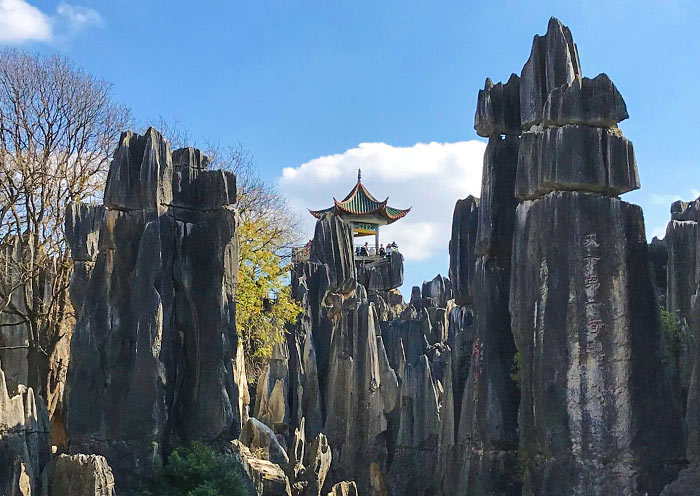

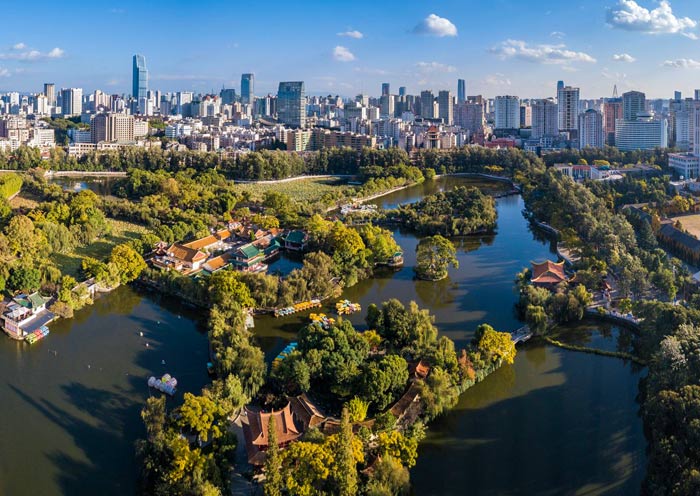
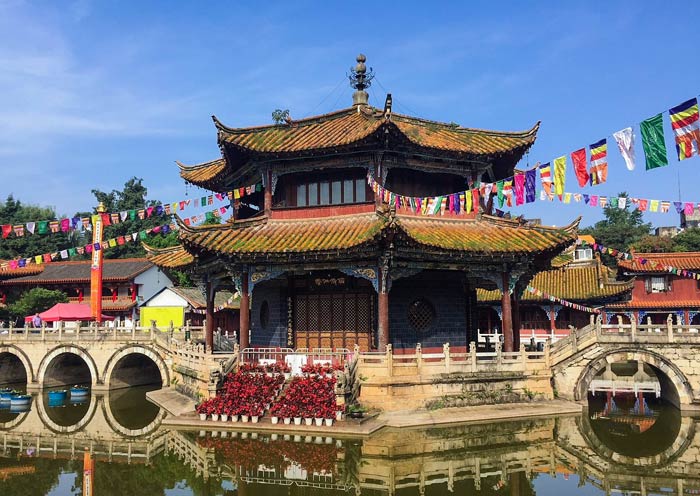
In this morning, you will be escorted to the train station for a high speed train to Dali (about 2 hours). Upon your arrival at Dali train station, our local tour guide and driver will meet you at the exit. They will then escort you to visit the Three Pagodas of Chongsheng Temple, providing a deep insight into Dali's historical and spiritual heritage.
The Three Pagodas of Chongsheng Temple (崇圣寺三塔景区), majestically set against the backdrop of the Cangshan Mountains and overlooking Erhai Lake, are the iconic symbol of Dali. The three pagodas (三塔), located at the front part of the complex, consist of one larger pagoda, known as Qianxun Pagoda about 69 meters high, flanked by two smaller ones. According to local legends, Dali was once a swamp inhabited by dragons that caused natural disasters, the Three Pagodas were built to deter the dragons. Take your time to closely observe the architectural details and the craftsmanship that have enabled these structures to stand tall and unyielding through the centuries. Don't miss the beautiful reflection pond in front of the pagodas, which provide stunning reflective views of the structures, perfect for photography.
After visiting the pagodas, proceed to Chongsheng Temple (崇圣寺) just behind them. This temple once served as the royal temple of the Dali Kingdom of Nanzhao with the good reputation of being “the Capital of Buddhism”. It is also famous as Tianlong Temple in Jin Yong’s "Demi-Gods and Semi-Devils." As you follow your guide, you will explore various halls for worship, including the impressive Mahavira Hall, and enjoy the tranquil atmosphere of the temple grounds. From certain elevated points, you can enjoy sweeping panoramic views of the surrounding Cangshan Mountains and Erhai Lake.
After lunch, continue your journey with a leisurely bike ride along the west side of Erhai Lake (洱海). The name "Erhai" translates to "Ear-shaped Sea," reflecting its unique shape. It is the second-largest highland lake in the country and a key feature of the Dali Bai Autonomous Prefecture. As you pedal along the well-maintained lakeside path, the stunning views of the expansive blue lake waters bordered by the majestic Cangshan Mountains will leave you in awe. Along the route, you'll encounter quaint Bai villages, lush green fields, and vibrant flowers. The bike path offers numerous spots for you to pause and soak in the beautiful views, perfect for capturing memorable photographs.
After the tour, return to your hotel in Dali.
Free Time Idea:
In the evening, take the opportunity to independently explore the enchanting Dali Ancient Town (大理古城). As dusk settles, the town's vibrant night markets come alive. Unwind in one of the town's many cozy coffee shop or night bars. Dali Old Town, originally established during the Ming dynasty over 600 years ago, serving as the medieval capital of both the Nanzhao and Dali Kingdoms. Visitors can stroll through the ancient city and enjoy its unique sense of history and culture. The main streets of the ancient city, such as Renmin Road and Foreigner Street, have many well-preserved traditional Bai architecture and alleys to explore. Besides the Bai ethnic minority's traditional folk houses, the houses all with grey-green roof tiles, peculiar workshops, temples, schools, and churches with an antique flavor are scattered.
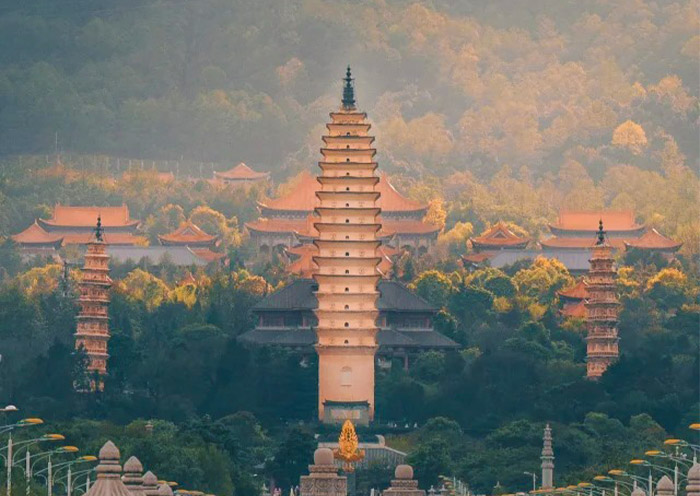
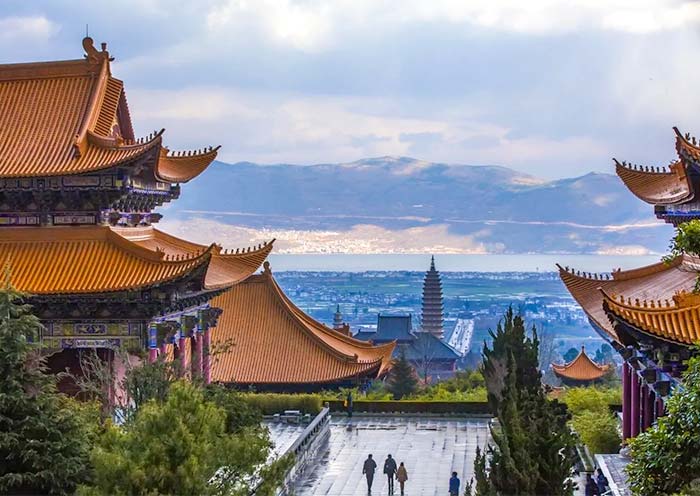
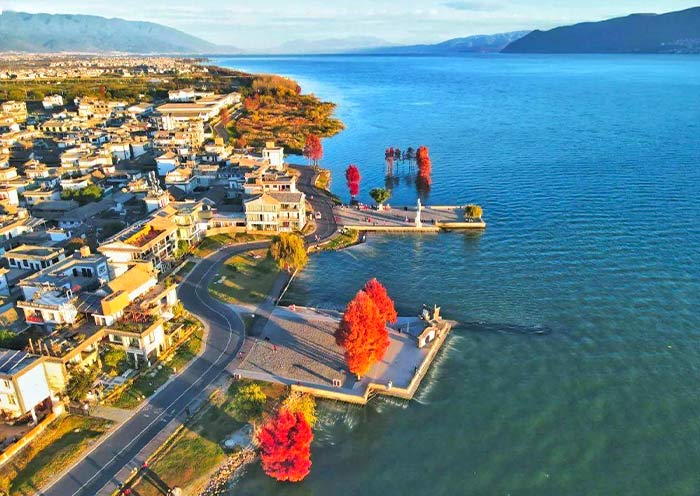
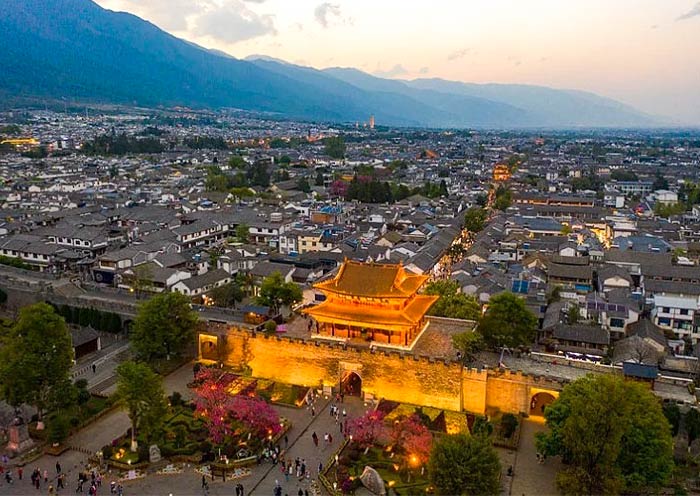
Start your delightful day by immersing yourself in the lively Xizhou Morning Market (喜洲早市)! There's no better way to get under the skin of a place than by exploring its local market, here you can witness firsthand the local customs and mouth-watering dietary habits. This market has been a gathering spot for over a century where locals trade a wide array of goods - from farm-fresh produce and unique handicrafts to tantalizing local snacks. Yunnan, fondly known as the "Kingdom of Flora and Fauna," is a place where flowers and insects find their way into the local cuisine! Don't be surprised if you come across unfamiliar vegetables, fruits, and wild mushrooms. While you're there, don't miss your chance to try local favorites like Xizhou baba (a tasty stuffed pancake, savory or sweet) and a cup of freshly brewed Yunnan coffee.
After exploring the market, take a walking tour of Xizhou Village (喜洲古镇), acclaimed as the "Premier Town of the Bai people" due to its exceptionally the largest and best-preserved cluster of Bai ethnic group's traditional dwellings. Xizhou Village is ideal for those seeking a more authentic and tranquil cultural experience of Bai life and traditions. As you wander through the village, visit some of the old mansions and Bai residences like Yan Family Compound (严家大院), you'll notice the most distinctive features of Bai architecture known as "Three-Room and One-Screen Wall (三房一照壁)" and "Siheyuan/Courtyard (四合院)”. These homes are adorned with exquisite details such as flying eaves, ornately carved wooden doors and beautifully painted walls typical of Bai aesthetics. Don't miss the "Three Courses of Tea" ceremony (三道茶), a Bai cultural practice you must experience. This tea ceremony, which transitions from bitter to sweet to an aftertaste, encapsulates the philosophy of "embraces hardship, values the sweetness that follows struggles, and reflects on the profound aftertastes that life experiences leave behind". In addition, Xizhou is surrounded by vast wheat fields, creating a striking contrast against the grey-and-white tones of the Bai minority dwellings. This harmonious coexistence with nature provides a healing, wonderful feeling. The beautiful scenery, especially in spring and autumn, draws tourists to appreciate Xizhou's charms.
Next, make your way to Zhoucheng Village, which is just a short drive from Xizhou. Zhoucheng Village (周城), is often referred to as the “Hometown of Bai Embroidery ”. It is Bai people village, famous for its traditional tie-dye art (扎染), which has been preserved and passed down through generations. The Bai tie-dye technique has been listed as a National Intangible Cultural Heritage. Explore workshops within the village that showcase exquisite Bai embroidery. These pieces often depict traditional motifs such as lotus flowers, fish, and birds, which carry significant cultural symbolism. Engage with the local craftsmen and women, many of whom have inherited their skills from generations. If you're lucky, you may witness live demonstrations of Bai embroidery and tie-dye techniques. Optional Activity: If interested, participate in a hands-on workshop and craft your own tie-dye fabric under the guidance of expert artisans.
Later, continue driving to Lijiang (about 140 kilometers, around 2 hours). Lijiang (丽江), nestled under the breathtaking Jade Dragon Snow Mountain, forms a beautiful and peaceful link between Shangri-La to the north and Dali to the south. A UNESCO World Heritage site named "Old Town of Lijiang", it's not only a living ancient town complex, encompassing Dayan, Shuhe, and Baisha, but also the heartland of the Naxi ethnic group, with about 74% of the population being Naxi. A visit to Lijiang allows you to enjoy endless snow-capped mountain views, appreciate the charming old town, experience the rich Naxi culture, and unwind in its peaceful atmosphere.
This afternoon, you will have some time to explore Lijiang Old Town (丽江古城), also known as Dayan Old Town. With over 800 years of history, Lijiang Old Town was once a bustling hub for trade along the famous "Old Tea Horse Caravan Trail". The town resembles a labyrinth, characterized by its numerous cobbled streets, traditional wooden houses with upturned eaves, ancient bridges, and an intricate network of waterways. If time permits (optional), you'll visit the Mu Palace (木府), a sprawling complex located in the heart of Lijiang Old Town, often referred to as the “Forbidden City of the South”. It offers a captivating glimpse into the grandeur of Naxi royalty, showcasing rich Naxi culture and the fascinating history of the Mu family. You'll also discover why Lijiang Old Town, unlike the top three most famous ancient Chinese cities, has no city wall. Afterwards, walk to a higher vantage point to capture a breathtaking panoramic view of the sprawling old town, with snow-capped mountains forming a majestic backdrop in the distance. Take a short walk to Sifang Street (四方街), the most famous square. Here, you can explore Naxi handicrafts, souvenirs, and local specialties, and soak up the vibrant atmosphere of bustling bars with lively music spilling out onto the streets.
Afterward, let's head to Black Dragon Pond Park (黑龙潭公园), located at the northern edge of Lijiang Old Town. This picturesque location offers stunning views of the surrounding landscape, highlighted by the majestic Jade Dragon Snow Mountain. On clear days, the reflection of the snow-capped peak on the tranquil water of the Black Dragon Pool creates a breathtaking scene.
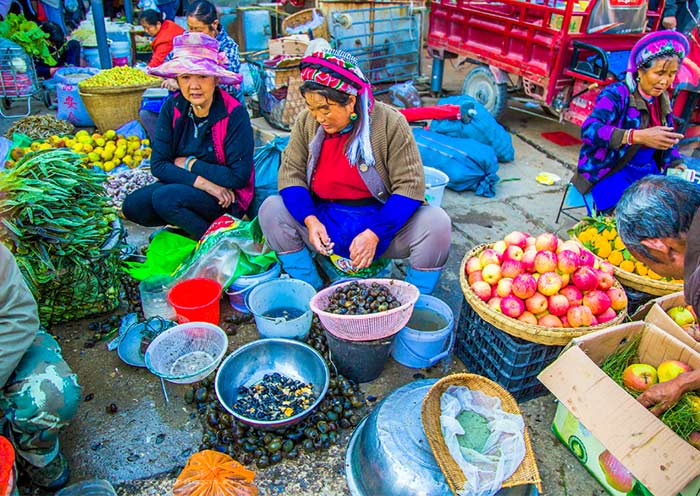
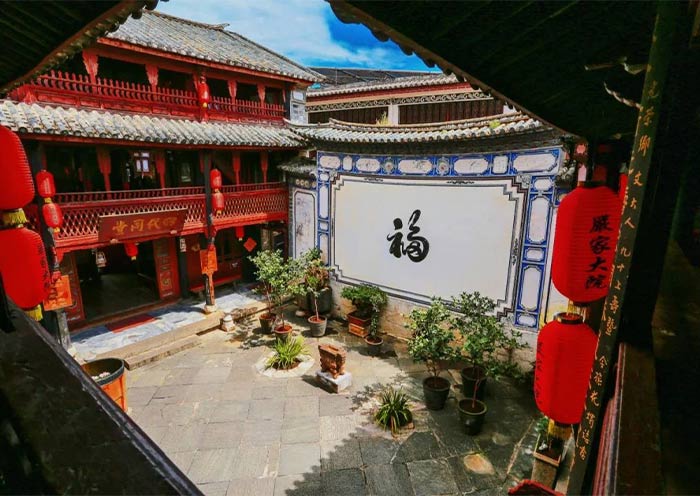


After breakfast, it's time to venture beyond Lijiang Old Town and explore the renowned Jade Dragon Snow Mountain (玉龙雪山). This majestic mountain is famous for its towering peaks, stunning scenery, and abundant biodiversity. It was designated as a UNESCO World Heritage site in 2003. The mountain gets its name from its resemblance to a stainless jade dragon, especially during winter when its peaks are covered in thick snow.
The crown jewel of the region is the sight of 13 snow-capped peaks, with the highest peak named Shanzidou, reaching an impressive elevation of 5,596 meters (18,360 ft). To fully experience the mountain, it is recommended to take a 10-minute cable car ride up to Spruce Meadow (云杉坪), situated at 3,240 meters. The cable car ride itself is a remarkable experience, offering breathtaking views of the surrounding mountains and valleys. Once you reach the top, you'll be greeted by awe-inspiring panoramic views and have the opportunity to explore meadows and pristine forests. After the tour, take cable down the mountain.
Afterward, take a sightseeing bus to Blue Moon Valley (蓝月谷). The valley is a breathtaking sight, with its almost surreal turquoise blue water, reflecting the majestic Jade Dragon Snow Mountain in the background. This valley boasts four lakes and a White Water Terrace. Each lake presents unique scenery, but the most beautiful one is the Jade Liquid Lake. The best time to admire the splendor of Blue Moon Valley is during a sunny midday when the lake's water, under the radiant sunlight, becomes as clear and blue as a mirror. You can capture many awesome photos here.
Optional Activity: Impression Lijiang" Show This Afternoon
If you're interested, you can choose to watch the Impression Lijiang show this afternoon at Ganhaizi (altitude: 3,100 meters). Directed by the renowned filmmaker Zhang Yimou, this magnificent open-air performance features singing and dancing that showcase the traditions and lifestyle of the local Naxi ethnic people. It lasts about one hour.
Leaving the Jade Dragon Snow Mountain, you'll continue your journey to Baisha Village (白沙村), the birthplace of the Mu chieftaincy and the ancient capital of the Naxi ethnic group. Part of the UNESCO World Heritage Site "Old Town of Lijiang", Baisha Village offers a unique glimpse into the Naxi group’s rich history and culture. Here, you can visit the Baisha Murals (白沙壁画), showcasing a unique fusion of Buddhist, Taoist, and local Naxi religious elements, reflecting the diverse spiritual beliefs of the region. These murals are found within several temples, including the Dabaoji Palace, the Liuli Temple, and the Wenchang Palace.
Then, if your energy permits (optional), on the way back to Lijiang, you can make a stop at Shuhe Ancient Town (束河古镇). It is an important stop along the legendary Tea Horse Ancient Road. Unlike the bustling Lijiang Old Town, Shuhe offers a tranquil escape, with charming shops selling locally-made crafts lining the narrow cobbled streets. The gentle murmur of water flowing through canals and the aroma of Naxi cuisine wafting from cozy teahouses create a peaceful atmosphere where time seems to slow down. (Note: You can try local snacks like Chicken Bean Cold Noodles, Grilled Milk Fan, Fresh Flower Cake, Yunnan Ham Mooncake, and Jar-Roasted Rose Milk.)
After the tour, head back to Lijiang.

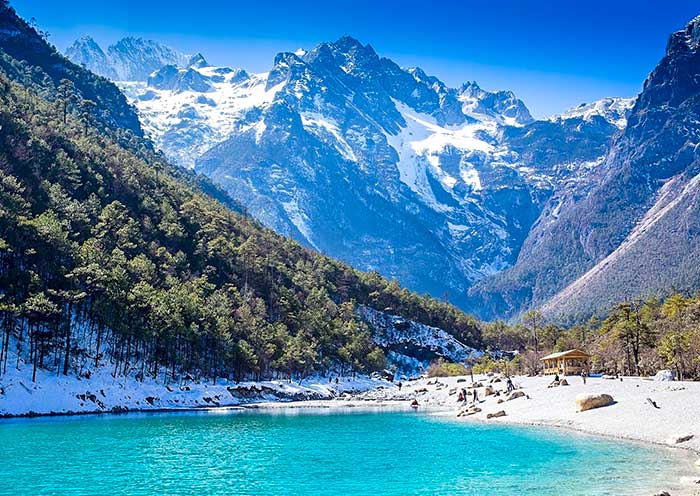

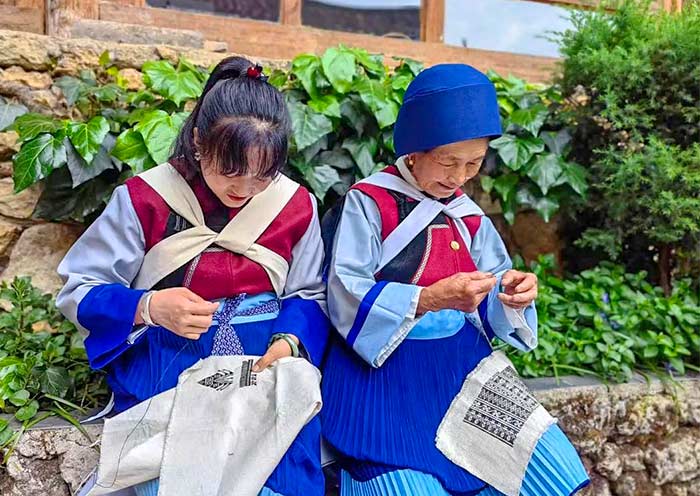
After breakfast, your guide and driver will meet you at your hotel and whisk you away on a scenic journey from Lijiang to explore breathtaking natural landscapes.
Your first stop will be the First Bend of the Yangtze River (长江第一湾). Here, you will witness the majestic river making a dramatic 90-degree turn from south to east within a short distance of 1 kilometer. Ascend to the observation deck for views of the Yangtze River. Continue your drive to Shigu Town for a close view of the bend. Take a walk along the river and admire the historic Iron Chain Bridge. In the charming Shigu Old Town, don't miss the opportunity to visit the Red Army's Long March Memorial Monument.
Later, continue your drive to the Upper Section of Tiger Leaping Gorge (上虎跳, altitude: 1,800 meters). According to legend, the section got its name when a tiger, chased by a hunter, took a legendary leap across the narrowest point, cornered by the rushing Jinsha River (part of the Yangtze River) at the gorge's base. One of the deepest gorges in the world, Tiger Leaping Gorge offers a breathtaking view of the roaring Jinsha River, allowing you to feel the strong power of nature. As Jade Dragon Snow Mountain (5,596m) and Haba Snow Mountain (5,386m) stand on each side, you will immerse yourself in the beautiful and diverse landscapes. You will walk along the plankroad, both up and down. (Optional: If you want to save energy, you can use the lift, with an extra fee.)
After the tour, you will be escorted back to Lijiang's airport/train station for your departure.
Lijiang Departure Ideas (by Flight or High Speed Train):
(1) Lijiang Sanyi Airport offers direct flights to major cities in China, including Beijing, Xi'an, Shanghai, Guangzhou, Chengdu, Chongqing, Hangzhou, Nanjing, Changsha, Wuhan, and more. It also offers international flights to Bangkok (Thailand), Ho Chi Minh City and Hanoi (Vietnam), Seoul (South Korea), and others.
(2) Additionally, if you are looking for more international flight options, it is recommended to take a high-speed train to Kunming (3.5-4 hours), where Kunming International Airport provides a broader range of flight options.
Extension Ideas: If you wish to extend your trip and explore other highlighted parts of Yunnan, such as Shangri-La, Yuanyang Rice Terraces, Xishuangbanna, and more, we can help you with the arrangements.
Thank you for choosing Asia Odyssey Travel for your Guilin Yunnan tour, we are always here working for you and hope to see you again for your next trip to China/Asia. Safe journey!
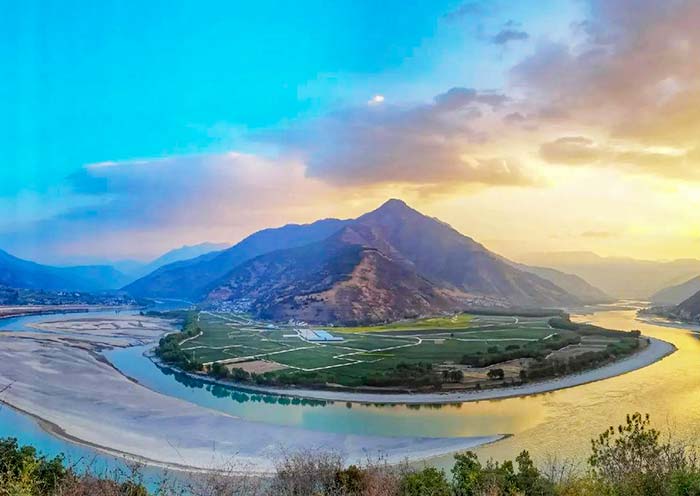
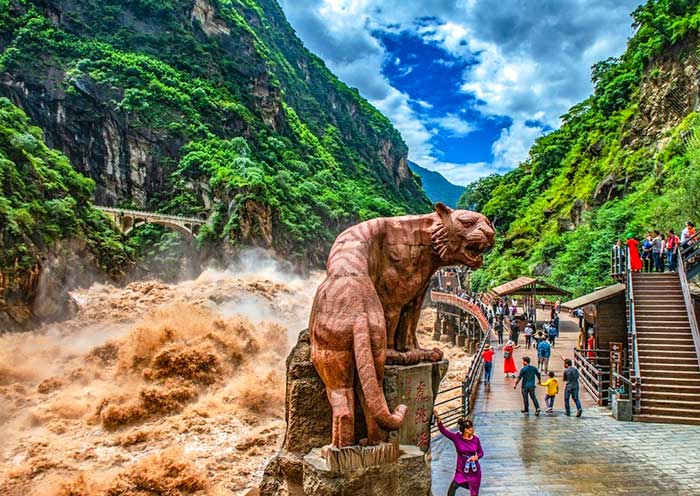
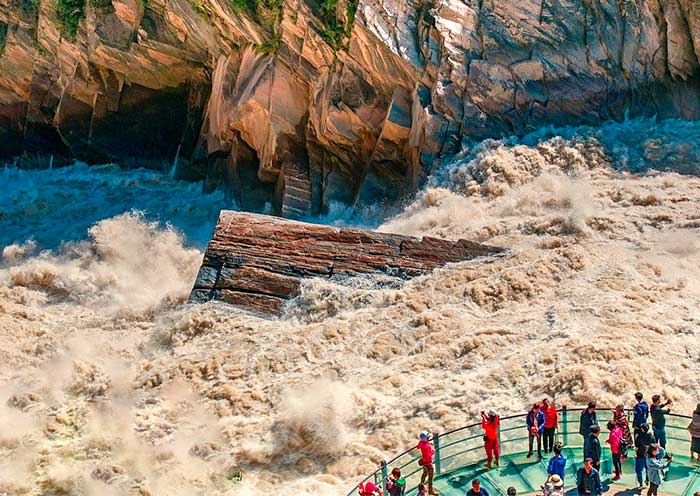
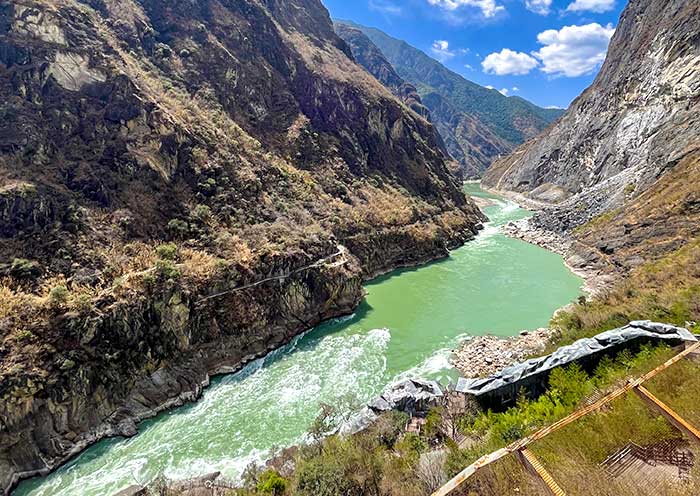
Price: What’s Included & What’s Excluded
What's Included:
What's Excluded:
Important Travel Tips for Visiting Yunnan
Yunnan is a highly mountainous province, with many destinations situated at high elevations. Be prepared for potential altitude sickness, especially if traveling to places like Lijiang (2,400m) or Shangri-La (3,400m). Acclimate gradually and stay hydrated.
Yunnan's climate can vary dramatically, even within the same day. Bring clothing that can be easily layered, as temperatures can fluctuate significantly, especially in the highlands.
The high-altitude sun in Yunnan can be intense. Wear sunscreen, hats, and sunglasses to protect yourself from sunburn and UV exposure.
Yunnan is home to a diverse array of ethnic minority groups. Be mindful of local customs and traditions, and ask for permission before taking photographs of people.
Yunnan is renowned for its diverse and flavorful cuisine. Be adventurous and sample local specialties like crossing-the-bridge noodles, Yunnan ham, and the region's unique variety of mushrooms.
Yunnan can experience sudden changes in weather, from heavy rains to snow, even during the same trip. Pack appropriate clothing and gear to be prepared for varying conditions.
By keeping these tips in mind, travelers can help ensure a safe, enjoyable, and enriching experience during their visit to the stunning Yunnan province.
Hotel Conditions for Your Yunnan Tour
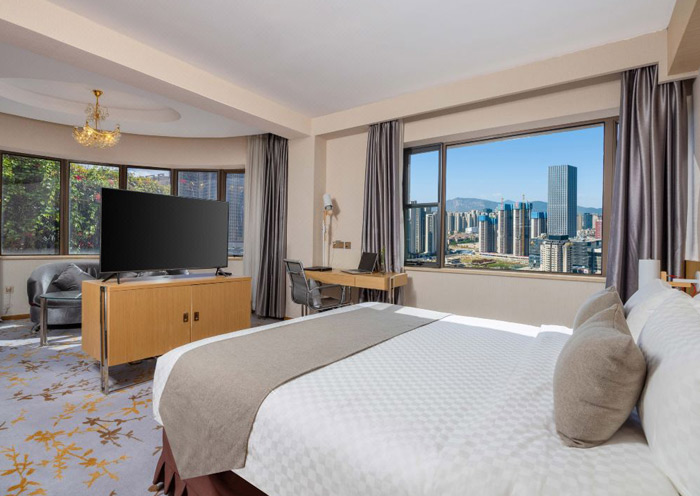

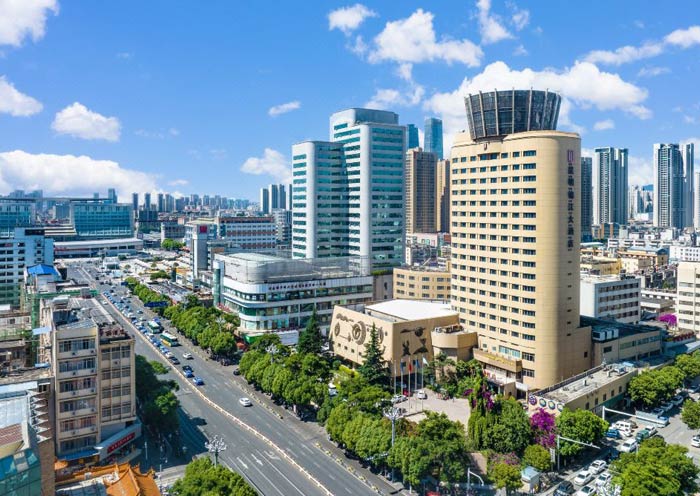
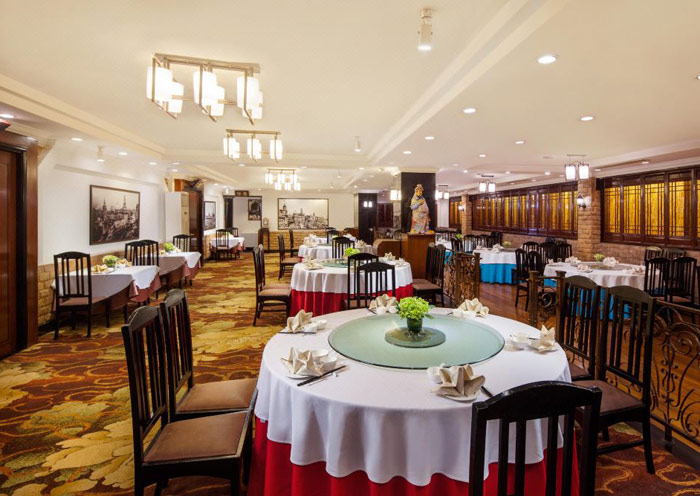
In Yunnan, there are many different hotel styles and types to choose from. No matter travelers choose to overnights in Kunming, Shilin, Yuanyang, Jianshui, Dali, Lijiang, or Shangri-la.
To cater to diverse traveler preferences and budgets, we offer a curated selection of accommodations. Our options include luxurious 5-star hotels, comfortable 4-star options, and economical 3-star establishments. All our selected hotels are conveniently located near city centers or popular tourist spots.
Find your perfect hotel for a great Yunnan experience! Our knowledgeable travel experts can provide you with various pricing options based on different hotels. Whether you seek a luxurious stay or have specific preferences, our experts will assist you in choosing the best option that suits your needs.
Photo Gallery for This Itinerary
Latest Yunnan Tours Reviews from Our Customers

Eileen
Singapore
Destination(s): Yunnan
Date of Experience: Dec 01, 2024
Tour Customized by: Hannah
You May be Interested in This Tour: Customized Tour

Eduard Melli
Switzerland
We had a great time in our tours in Yuanyang and Beijing. Olivia was very helpful in the organization, precise and quick.
Wendy was very caring and entertaining, always on time.
Jiang in Beijing was very nice, funny and gave us a lot of information, and was also a great hiker and photographer on the Great Wall
Destination(s): Beijing, Yunnan
Date of Experience: Mar 29, 2025
Tour Customized by: Olivia
You May be Interested in This Tour: Customized Tour

Eileen
Singapore
We booked it through Asia Odyssey Travel and it was one of the great decisions we made.
We wanted a private tour, just the Six of us with our private car, driver, and English-speaking guide, From the start, a special mention travel consultant, please do look for her - Alina from 成都 AOT was efficient in planning our itinerary based on our requirements, and was always accommodating when we wanted some changes made along the way. Her responses were fast , caring and meet our requested according without disappointment.
Their transport arrangements, selection of Hotels, internal transport transfers, etc were all top-notch.
Special mention must be made to the following personnel who took care of us:
Tour Guides in Yunnan:
1. Kuning: Colin
2. Lijiang: AMY Du
3. Shangri-la: Lobsang
They were so knowledgeable about the history & local cultures and so ready to attend to all our needs and requested.
A special shout out to 和师傅, he is an efficient, super careful driver and caring toward all people. He took great care of us and the your guide during the journey. He make sure our safety come first at all time.
A big Thank You, Alina, and Asia Odyssey Travel for making our holiday so memorable.
Best wishes !
Destination(s): Yunnan
Date of Experience: Oct 13, 2024
Tour Customized by: Alina
You May be Interested in This Tour: 8 Days Kunming Dali Lijiang Shangri-La Tour: Yunnan Best Highlights
Price: Request
(Based on a private tour for two people. Price varies depending on program, travel date, number of people.)
Free Enquiry! You don’t need to pay for the reservation.
- United States (+1)
- Australia (+61)
- Singapore (+65)
- Malaysia (+60)
- Philippines (+63)
- Canada (+1)
- Italy (+39)
- Indonesia (+62)
- United Kingdom (+44)
- Spain (+34)
- Mexico (+52)
- Hong Kong (+852)
- Thailand (+66)
- United Arab Emirates (+971)
- New Zealand (+64)
- South Africa (+27)
- Germany (+49)
- Brazil (+55)
- India (+91)
- France (+33)
- Vietnam (+84)
- The Netherlands (+31)
- Saudi Arabia (+966)
- Ireland (+353)
- Argentina (+54)
- Switzerland (+41)
- Romania (+40)
- Pakistan (+92)
- Japan (+81)
- Portugal (+351)
- Bangladesh (+880)
- South Korea (+82)
- Puerto Rico (+1)
- Türkiye (+90)
- China (+86)
- Belgium (+32)
- Qatar (+974)
- Greece (+30)
- Taiwan (+886)
- Austria (+43)
- Poland (+48)
- Israel (+972)
- Chile (+56)
- Sri Lanka (+94)
- Nigeria (+234)
- Peru (+51)
- Colombia (+57)
- Hungary (+36)
- Nepal (+977)
- Denmark (+45)
- Bulgaria (+359)
- Norway (+47)
- Slovenia (+383)
- Sweden (+46)
- Kuwait (+965)
- Costa Rica (+506)
- Ecuador (+593)
- Venezuela (+58)
- Malta (+356)
- Croatia (+385)
- Tunisia (+216)
- Czechia (+420)
- Mongolia (+976)
- Bahrain (+973)
- Mauritius (+230)
- Papua New Guinea (+675)
- Cambodia (+855)
- Dominican Republic (+1)
- Luxembourg (+352)
- Finland (+358)
- Guatemala (+502)
- Myanmar (+95)
- Maldives (+960)
- Slovakia (+421)
- Laos (+856)
- Serbia (+381)
- Brunei (+673)
- Oman (+968)
- Macao (+853)
- Panama (+507)
- Morocco (+212)
- Jordan (+962)
- Georgia (+995)
- Fiji (+679)
- Bolivia (+591)
- Lithuania (+370)
- Bahamas (+1)
- Cyprus (+357)
- Latvia (+371)
- Bhutan (+975)
- Iraq (+964)
- Iran (+98)
- Kenya (+254)
- Jamaica (+1)
- Zimbabwe (+263)
- Azerbaijan (+994)
- Uruguay (+598)
- Estonia (+372)
- Andorra (+376)
- Cameroon (+237)
- Ghana (+233)
- Kazakhstan (+7)
- Nicaragua (+505)
- Egypt (+20)
- Russia (+7)
- Albania (+355)
- Réunion (+262)
- Montenegro (+382)
- Algeria (+213)
- Afghanistan (+93)
- Martinique (+596)
- Uganda (+256)
- Honduras (+504)
- North Macedonia (+389)
- Trinidad and Tobago (+1)
- Suriname (+597)
- Antigua and Barbuda (+1)
- Zambia (+260)
- Ukraine (+380)
- Armenia (+374)
- Barbados (+1)
- Belarus (+375)
- Palestine (+970)
- Lesotho (+266)
- Moldova (+373)
- Ethiopia (+251)
- French Polynesia (+689)
- Gambia (+220)
- Guam (+1)
- Gibraltar (+350)
- Isle of Man (+44)
- New Caledonia (+687)
- El Salvador (+503)
- Comoros (+269)
- Seychelles (+248)
- Chad (+235)
- Samoa (+685)
- Cook Islands (+682)
- Palau (+680)
- Paraguay (+595)
- DR Congo (+243)
- Solomon Islands (+677)
